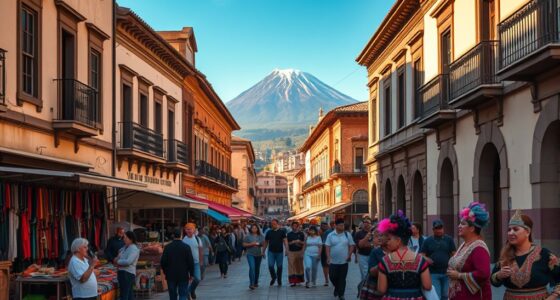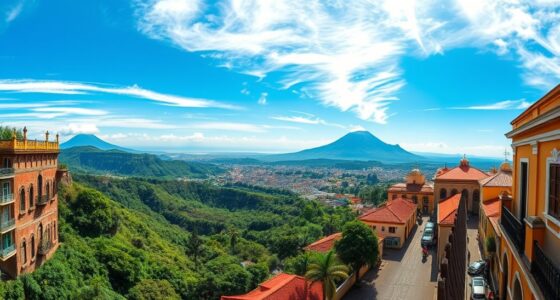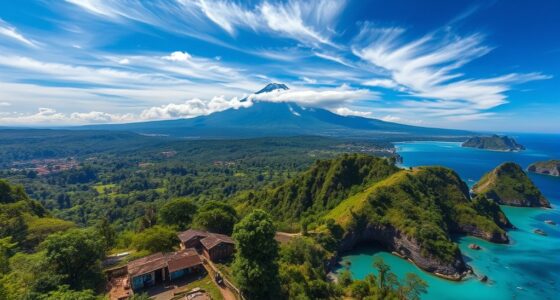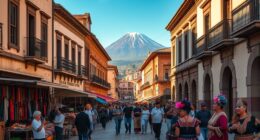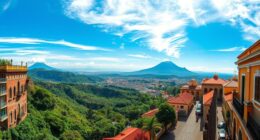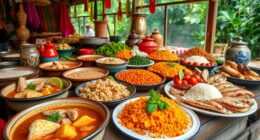Ecuadorian cuisine offers a vibrant mix of regional flavors, blending indigenous ingredients like potatoes, corn, and yuca with Spanish, African, and Asian influences. You’ll find Highland dishes like hornado and locro, coastal seafood favorites like ceviche, and Amazonian specialties featuring tropical fruits and freshwater fish. Traditional celebrations showcase unique foods such as fanesca and colada morada. If you want to explore more about Ecuador’s rich culinary customs and diverse dishes, there’s plenty to discover ahead.
Key Takeaways
- Ecuadorian cuisine is shaped by regional ingredients and diverse geography, featuring Highland, Coastal, and Amazonian dishes.
- Traditional ingredients like potatoes, yuca, corn, and seafood are combined with indigenous, Spanish, African, and Asian influences.
- Iconic dishes include hornado, ceviche, fanesca, and cuy asado, each reflecting regional customs and festive celebrations.
- Popular street foods such as bolon de verde, empanadas, and llapingachos are integral to daily culinary customs.
- Daily meals follow a structured pattern with hearty lunches, flavorful soups, and regional sweets like colada morada and dulce de higos.
Regional Influences and Traditional Dishes
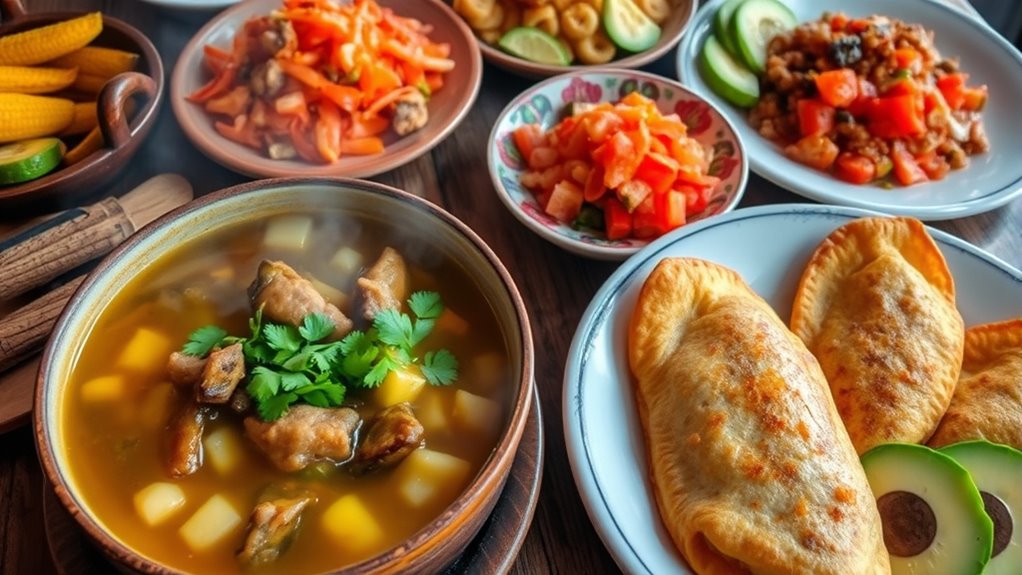
Ecuador’s diverse geography profoundly shapes its culinary traditions, with each region developing unique dishes using locally available ingredients. In the highlands, you’ll find hearty dishes like hornado and locro de papa, emphasizing potatoes, pork, and cheese. The coast specializes in seafood-based meals such as ceviche and encebollado, highlighting fresh fish and shellfish. The Amazonian region offers dishes with yucca, freshwater fish, and tropical fruits, reflecting indigenous practices. You notice how each area’s ingredients influence its cuisine, creating distinct flavors and textures. While national favorites like ceviche and hornado are enjoyed across Ecuador, their preparation varies regionally. This regional diversity guarantees that Ecuadorian cuisine offers a rich tapestry of tastes shaped by geography, climate, and local culinary influences.
Staple Ingredients Across Ecuadorian Cuisine
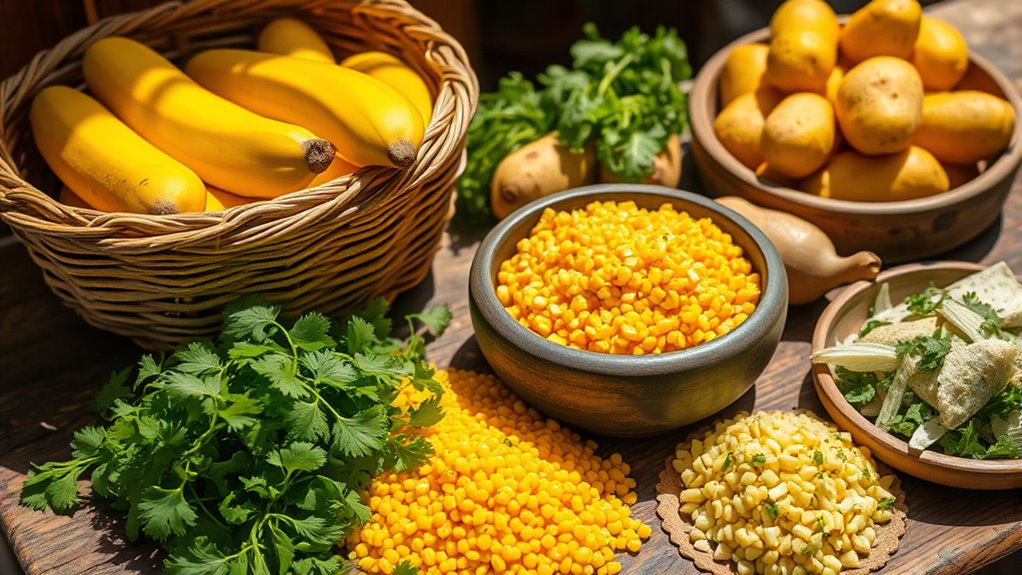
Across Ecuador’s diverse regions, certain ingredients form the foundation of most dishes, uniting the country’s culinary traditions despite regional differences. You’ll find that key staples like these create the backbone of Ecuadorian meals:
- Bananas and plantains — essential for both savory and sweet dishes, especially in the coast and Amazon.
- Potatoes — a highland staple, used in soups, stews, and side dishes.
- Corn — featured in tortillas, tamales, and beverages like chicha.
- Yucca — a root vegetable common in Amazonian and highland cuisines, often boiled or fried.
Herbs like cilantro, garlic, and onions elevate flavors, while lime and avocado add fresh notes across regions. These ingredients reflect Ecuador’s rich agricultural diversity and culinary heritage.
Iconic Ecuadorian Dishes and Their Regional Variations
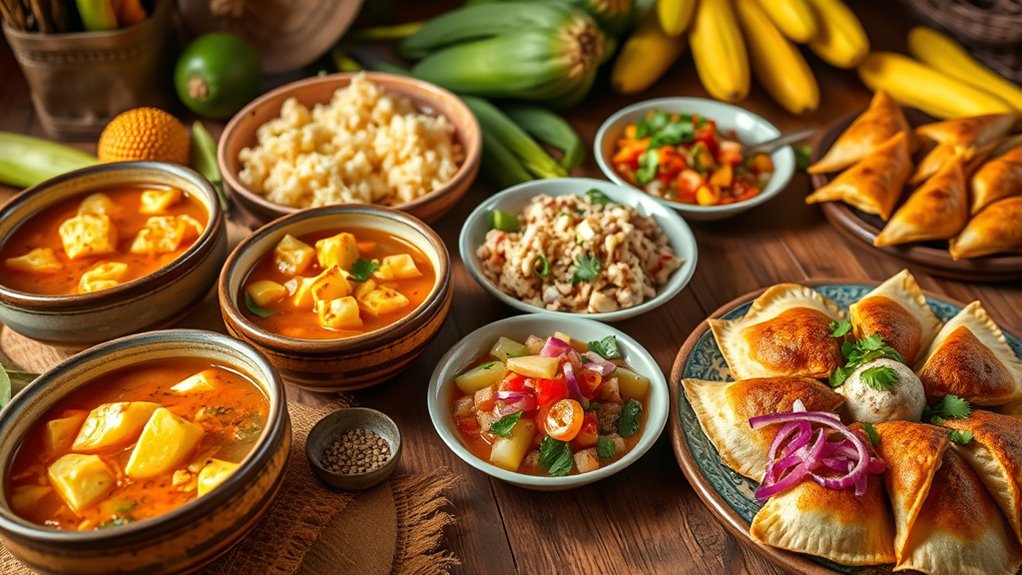
You’ll notice that Ecuadorian dishes vary markedly by region, reflecting local ingredients and traditions. Highland classics like hornado and locro de papa showcase potatoes and pork, while coastal specialties such as ceviche and encebollado highlight seafood and tropical flavors. In the Amazon, you’ll find dishes with yucca, freshwater fish, and tropical fruits, emphasizing indigenous culinary influences. Exploring these regional variations can inspire unique plot ideas that sell for writers interested in diverse settings.
Highlands Classics
Have you ever wondered how the highlands’ rugged landscape shapes Ecuador’s most cherished dishes? The Sierra’s terrain influences hearty, comforting foods you’ll find across the region. Here are four iconic highland dishes:
- Hornado: Slow-roasted pork marinated with garlic, cumin, and achiote, often served with mote and plantains.
- Locro de Papa: Creamy potato soup enriched with cheese, avocado, and annatto, perfect for chilly days.
- Fanesca: Festive soup made with 12 grains, salt cod, and vegetables, enjoyed during Holy Week.
- Cuy Asado: Roasted guinea pig, a traditional delicacy prepared with herbs and spices.
These dishes showcase regional ingredients and traditions, offering a taste of highland Ecuador’s culinary soul.
Coastal Specialties
What makes Ecuador’s coastal cuisine so vibrant and distinctive is its emphasis on fresh seafood and tropical ingredients. You’ll find dishes like ceviche, where marinated shrimp or fish are combined with lime, cilantro, and onions for a tangy, invigorating flavor. Accompanying snacks such as chifles (plantain chips) and empanadas add variety and crunch. Seafood dominates, with shrimp, conch, and fish featured in many recipes. Regional variations include the spicy encocado, a coconut-based seafood stew from Guayaquil, and the popular encebollado, a fish and yucca soup considered a national hangover cure. Plantains, coconut, and tropical fruits are common ingredients, often used in both savory and sweet dishes. Street vendors serve quick bites, making coastal cuisine lively and accessible.
Amazonian Flavors
While coastal dishes highlight the bounty of seafood and tropical fruits, Amazonian cuisine offers a unique array of flavors rooted in indigenous traditions and the rainforest’s abundant ingredients. You’ll find dishes that showcase yucca, freshwater fish, and tropical fruits, reflecting local customs. To deepen your understanding:
- Majado de Yuca: Mashed yucca mixed with fish, herbs, and spices, often used as a side or main dish.
- Chucula: Thick, sweet porridge made with plantains, cocoa, and tropical fruits, served as a dessert or breakfast.
- Tacacho con Cecina: Roasted plantain mashed with pork, paired with dried, smoked beef.
- Cocada de Puyo: Coconut and tropical fruit dessert with a hint of citrus, highlighting rainforest ingredients.
Popular Street Foods and Snacks
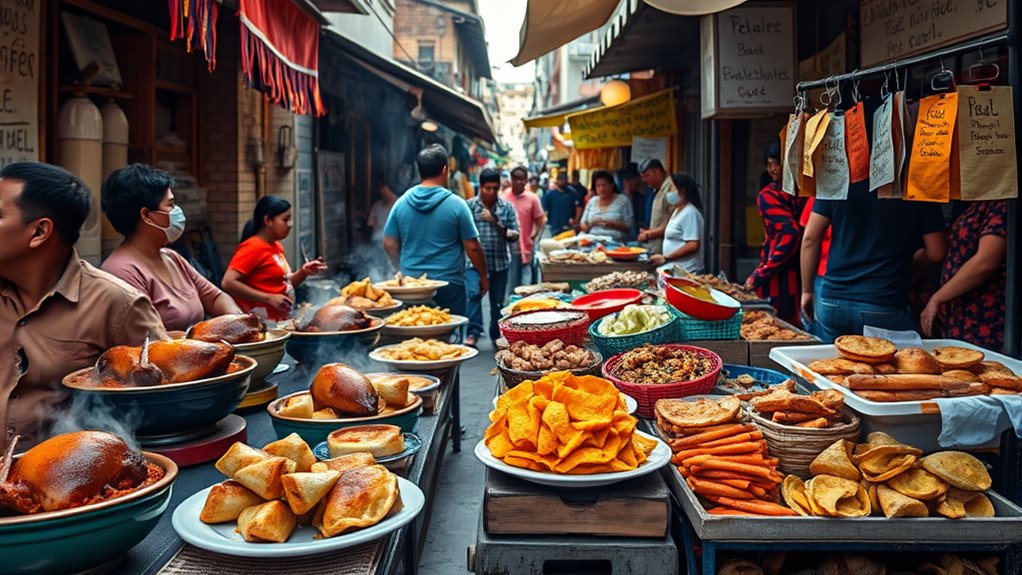
Ecuador’s vibrant street food scene offers a delicious array of snacks that reflect the country’s diverse culinary traditions. You’ll find tasty treats everywhere, from bustling markets to street corners. Popular snacks include bolon de verde—fried green plantain balls filled with cheese or meat—and empanadas, which are flaky pastries stuffed with cheese, meat, or vegetables. Llapingachos are crispy potato pancakes often served with chorizo and peanut sauce, while chifles are crunchy fried plantain chips ideal for snacking. Humitas, steamed corn parcels filled with cheese or meat, are also common. Rustic ingredients play a key role in many of these traditional recipes, highlighting Ecuador’s agricultural richness. Here’s a quick look at some street favorites:
| Snack | Description |
|---|---|
| Bolon de Verde | Fried plantain balls stuffed with cheese or pork |
| Empanadas | Pastries filled with meat, cheese, or vegetables |
| Llapingachos | Potato pancakes with cheese and peanut sauce |
Beverages and Traditional Sweets
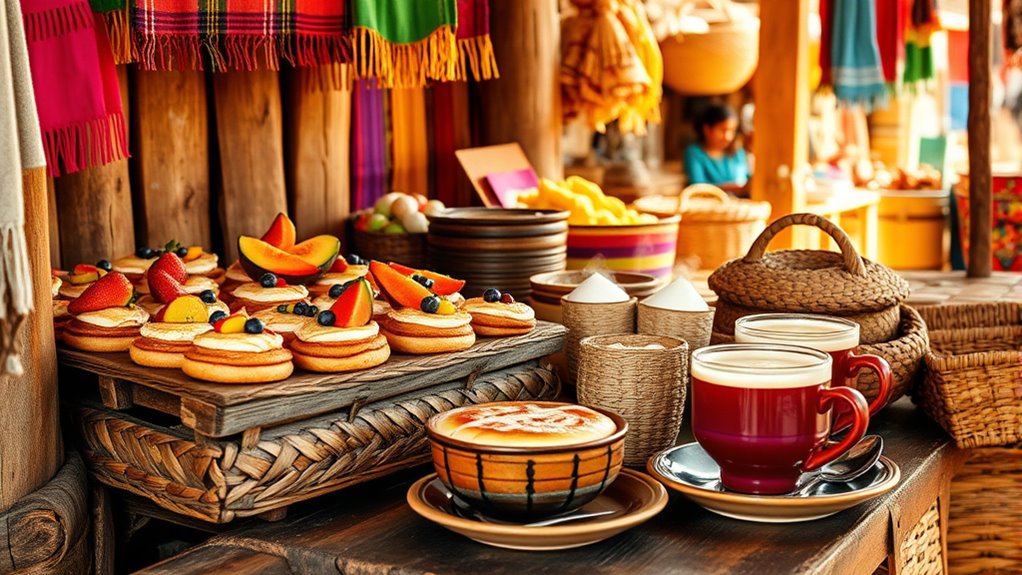
As you explore Ecuador’s vibrant street food scene, you’ll notice that beverages and traditional sweets play an essential role in complementing the country’s diverse flavors. These treats reflect regional ingredients and cultural influences, making them unique and memorable. Here are some highlights:
- Colada Morada: A spiced purple corn drink with berries, enjoyed during Day of the Dead with guagua de pan, a sweet bread shaped like a baby.
- Canelazo: A warm, cinnamon-spiced alcohol made from sugarcane, perfect for chilly highland nights.
- Morocho: A thick, sweet beverage blending ground corn, milk, cinnamon, and sugar, often served as a comforting drink.
- Dulce de Higos: Candied figs enjoyed as a traditional dessert, especially in the Sierra region.
- Incorporating juice yield information can help you better appreciate the local beverages’ ingredients and preparation methods.
Culinary Customs and Festive Food Practices

You’ll notice that Ecuadorian meals follow a traditional structure, with lunch as the main event and lighter dinners. During festivals and religious celebrations, special dishes like fanesca and humitas take center stage, reflecting local customs. These culinary practices highlight how regional ingredients and cultural traditions shape Ecuador’s festive food experiences. Additionally, the use of regional ingredients is essential in creating authentic dishes that preserve the country’s culinary heritage.
Traditional Meal Structures
Traditional meal structures in Ecuador often follow a daily rhythm that highlights the importance of lunch as the main social and nutritional event. You’ll typically start with a soup or broth, like locro de papa or encebollado, to warm up. The main course usually includes rice or pasta paired with a protein—pork, beef, or seafood—and vegetables or salads. Afterward, you might enjoy a sweet treat such as dulce de higos or a fruit-based dessert. Beverages like colada morada or canelazo accompany the meal, especially during festivities. These beverages are deeply rooted in Ecuadorian cultural traditions and are often enjoyed during special celebrations.
- Breakfast features light snacks like empanadas or bolon de verde.
- Lunch is the largest, most social meal of the day.
- Dinner remains simple: bread, herbal tea, or fruit.
- Special occasions involve unique dishes, blending indigenous and Spanish influences.
Festive Food Celebrations
Did you know that Ecuadorian festivals are vibrant showcases of its culinary heritage? During celebrations, special dishes take center stage, reflecting regional flavors and cultural traditions. For example, during Holy Week, you’ll enjoy fanesca, a hearty soup with 12 grains and salt cod, symbolizing unity and faith. In other festivities, roasted cuy (guinea pig) or hornado (slow-roasted pork) highlight highland traditions. Coastal celebrations feature ceviche and seafood-based dishes, while tropical fruits and sweets like dulce de higos add a festive touch. Street vendors serve quick bites like empanadas and bolon de verde, creating lively food scenes. These culinary customs bring communities together, honoring history, religion, and regional pride through flavorful, meaningful dishes that make Ecuador’s festivals truly unforgettable. Additionally, somatic therapy techniques are sometimes incorporated to enhance emotional well-being during these communal celebrations.
Regional Culinary Customs
Ecuadorian culinary customs are deeply rooted in regional identities, shaping the way people prepare and enjoy their food during everyday life and special occasions. You’ll notice how ingredients and flavors vary across regions, reflecting local traditions. For example, in the highlands, hearty potato soups and roasted pork dominate, while coastal areas feature fresh seafood and plantains. Indigenous influences blend with Spanish and African traditions, creating diverse dishes. To understand these customs, consider these key points:
- Highland dishes like hornado and locro de papa showcase root vegetables and roasted meats.
- Coastal cuisine emphasizes ceviche, seafood stews, and tropical fruits.
- Street foods such as bolón de verde and empanadas are common across regions.
- Festive foods, like fanesca and colada morada, highlight regional and cultural celebrations.
- Using traditional cooking techniques and locally sourced ingredients enhances the authenticity and richness of Ecuadorian dishes.
Fusion of Indigenous and External Culinary Influences
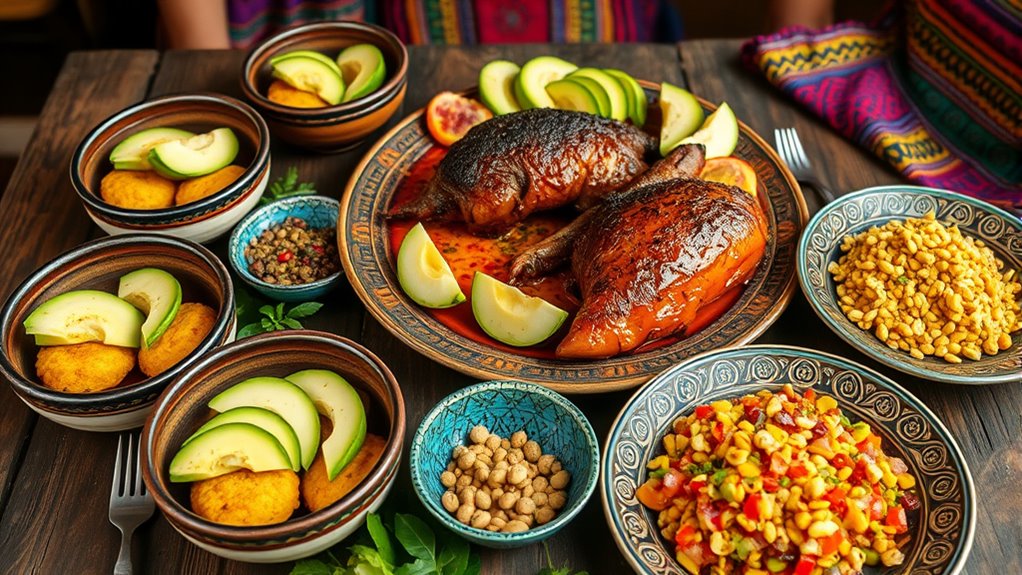
The culinary landscape of Ecuador reflects a dynamic fusion of indigenous traditions and external influences, shaped by centuries of cultural exchange. You’ll notice how indigenous ingredients like yuca, corn, and native herbs blend seamlessly with Spanish, African, and Asian flavors. For example, dishes like hornado incorporate Spanish marination techniques, while African influences appear in the use of peanuts and spicy seasonings. Seafood preparations, such as ceviche, combine indigenous methods with Spanish and Japanese techniques. Breads like humitas and bolon de verde showcase native corn, yet often include cheese or meat introduced through external contact. Beverages like canelazo and colada morada mix indigenous herbs and fruits with colonial sugarcane and spices. This blending creates Ecuador’s vibrant, diverse cuisine, rich in history and cultural adaptation. Additionally, cultural exchange over the centuries has enriched local cooking styles, making Ecuadorian cuisine a true reflection of its diverse heritage.
Frequently Asked Questions
How Do Regional Ingredients Influence Ecuadorian Flavor Profiles?
You notice that regional ingredients shape Ecuadorian flavors a lot. In the highlands, potatoes, corn, and meats give dishes hearty, earthy tastes. On the coast, seafood, plantains, and coconut add fresh, tropical notes. In the Amazon, yucca, freshwater fish, and fruits create unique, indigenous flavors. These ingredients influence every meal, blending local traditions and creating distinct regional profiles that make Ecuadorian cuisine rich and diverse.
What Are the Traditional Methods of Preparing Ecuador’s Signature Dishes?
You typically prepare Ecuador’s signature dishes through slow roasting, boiling, or frying. For hornado, you marinate pork with garlic, cumin, and achiote before roasting it slowly until tender. Ceviche involves marinating fresh seafood in lime juice with onions and cilantro. Encebollado is made by boiling fish with yuca, then adding onions, tomatoes, and spices. These methods highlight the flavors of local ingredients, emphasizing simplicity and traditional techniques.
How Do Indigenous and Spanish Culinary Traditions Blend in Ecuador?
Imagine a vibrant tapestry, where indigenous roots weave seamlessly with Spanish threads—you see this in Ecuador’s cuisine. You’ll notice indigenous ingredients like yucca and fresh fish blending with Spanish spices, herbs, and cooking techniques. This fusion creates dishes like ceviche and hornado, where native flavors meet colonial influences. You actively experience this harmony in every bite, as traditional methods and cultural stories intertwine to craft Ecuador’s rich, diverse culinary identity.
Which Ingredients Are Essential for Authentic Ecuadorian Street Food?
You’ll find that essential ingredients for authentic Ecuadorian street food include ripe plantains, yucca, and corn, which serve as staples in dishes like bolon de verde and humitas. Fresh seafood, especially on the coast, is key for snacks like chifles and ceviche. Herbs like cilantro, garlic, and onions add flavor, while local cheeses and meats such as chorizo or pork enhance fillings in empanadas and llapingachos.
How Do Religious Festivals Shape Ecuadorian Food Offerings?
During religious festivals, you’ll notice Ecuadorian food offerings become more traditional and symbolic. You’ll see dishes like fanesca, a hearty soup with 12 grains, served during Holy Week, while sweet treats like guaguas de pan and dulce de higos become popular. These celebrations emphasize sharing special foods with family and community, blending indigenous and Spanish influences, creating a vibrant culinary experience that honors faith and culture.
Conclusion
You explore Ecuador’s vibrant flavors, embrace its diverse ingredients, savor its traditional dishes, and celebrate its festive food customs. You taste the blend of indigenous roots and external influences, experience the lively street foods and sweet treats, and appreciate the rich culinary heritage that unites regions and communities. You carry this culinary journey in your heart, inspired by Ecuador’s passion for food, its history on your palate, and its warmth in every bite.


